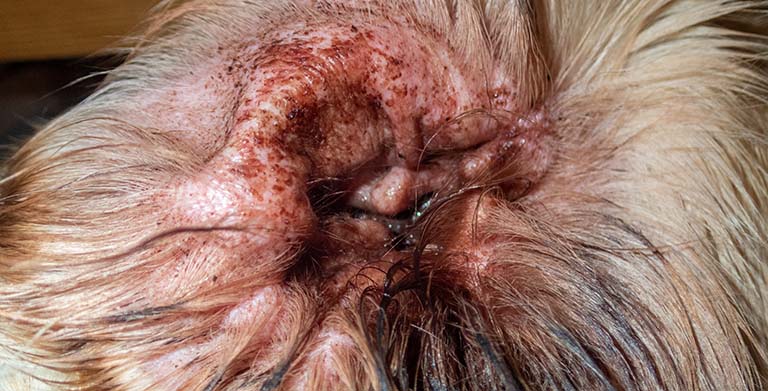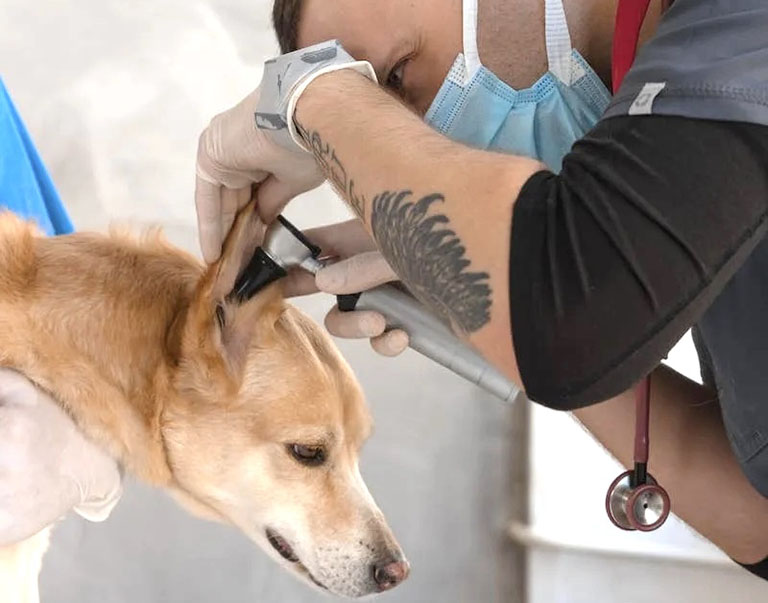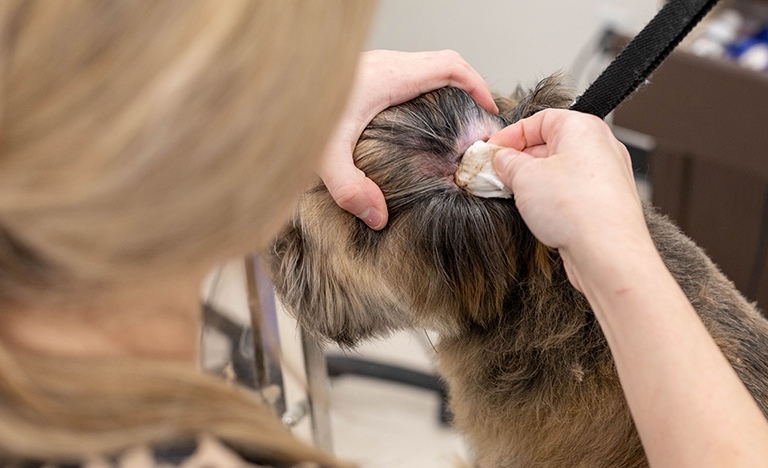All pet owners should learn the signs and symptoms of dog ear infections so they can take steps to relieve their uncomfortable pet in the event one occurs. If left unaddressed, ear infections in dogs can progress rapidly and lead to problems with balance and coordination, pain and facial paralysis (in severe cases). Read on to learn the signs your pet may have an ear infection along with information about the causes, prevention and treatment options available.
Signs of Ear Infections in Dogs
Your dog can’t tell you they have an ear infection, so it’s important to keep an eye out for any signs and symptoms. Keep an eye out for behaviors such as excessive scratching or rubbing of an ear, frequent head shaking or head tilting. Additionally, note any signs of redness or swelling in the pinnae (the visible part of the external ear). A clear indication may be the presence of crusting scabs or an abundance of ear wax inside the ear.
Watch for any pus discharge, which can vary in color, and be attentive to any noticeable odor emanating from the ear. It’s not uncommon to see a dark brown wax or a slimy discharge in ear infection cases. Identifying these symptoms promptly can aid in timely and effective intervention for your pet’s well-being.

Different Types of Canine Ear Infections
Ear infections in dogs come in three distinct types, each with its own set of characteristics and potential complications. Understanding these distinctions is crucial for identifying and addressing ear infections in dogs effectively.
Otitis externa (OE) affects the external ear canal. This is the most common form, and certain breeds such as cocker spaniels, miniature poodles and Old English sheepdogs are more susceptible to this condition because of the shape of their ears.
Otitis media (OM) occurs in the middle ear, situated just behind the eardrum. It can lead to partial facial paralysis, as the facial nerves pass through the middle ear. Frequently, OM is an extension of an infection from the outer ear, and it may even result in corneal ulceration.
Otitis interna (OI) affects the inner ear. In severe cases, infection can progress from the inner ear to the brain and lead to meningitis. Due to the infection’s proximity to vital nerves, OI can decrease a dog’s coordination and hearing.

Causes of Dog Ear Infections
Several factors contribute to ear infections. One common cause is the entrapment of moisture in the ear, creating the optimal environment for bacteria and yeast to grow. Excessive wax build-up, injuries to the ear canal and excessive ear cleaning can also trigger ear infections.
Pets with allergies and underlying medical issues have a higher risk of developing ear infections. Dogs with atopic dermatitis (skin disease caused by allergies) have a 50% higher risk while those with food sensitivities have an 80% higher risk. Medical issues such as endocrine disorder, thyroid disease and autoimmune disorders can also increase a dog’s risk for ear infections.
Treatments for Canine Ear Infections
If you notice your dog exhibiting common signs of ear infections, it’s crucial to promptly seek guidance from your veterinarian. Once diagnosed, the vet will clean your dog’s ears using a medicated ear cleanser. Prescription ear drops may be prescribed for at-home use, along with oral antibiotics and anti-inflammatory medications as necessary.
In most cases, uncomplicated ear infections show improvement within a week or two with proper treatment. However, more severe infections or those linked to underlying health conditions may require an extended resolution period, possibly spanning months. Adhering closely to your veterinarian’s instructions is essential, and attending recommended recheck appointments is equally important. Make sure to follow through with the full course of treatment prescribed by your vet, as failure to do so may lead to additional problems and cause your pet to develop a resistance to future ear infection treatments.

How to Prevent Ear Infections in Dogs
How to Dry Your Dog’s Ears
Drying your dog’s ears thoroughly after swimming or bathing is essential to prevent bacterial and yeast growth. Excess moisture in the ear canal creates an ideal environment for microorganisms to develop and can lead to infections and discomfort. Regular drying eliminates moisture and reduces the risk of infections, foul odors and irritation. It preserves the ear’s natural defenses and supports overall ear health.

How to Clean Your Dog’s Ears
Incorporating a regular ear-cleaning routine into your overall grooming and bathing regimen is a proactive measure to prevent infections in your dog. This not only aids in preventing infections but is also an important routine hygienic care need of your pet.
To effectively clean your dog’s ears, start by filling each ear canal with a veterinarian-approved cleaning solution. Gently massage the solution into the base of the ear for about two minutes, keeping in mind that this may cause some discomfort in inflamed ears. Allow your dog to shake their head to naturally expel any debris, and be prepared for some discharge during this process.
Next, use cotton balls to delicately wipe away debris from the ear, making sure not to go deeper than your fingers can reach. Avoid using Q-tips, as these can push debris further down. Repeat the cleaning process until the cotton balls come out clean, which may require several repetitions.
Ideally, there shouldn’t be a significant amount of debris during each cleaning. If excessive debris persists, you may need to clean more frequently or consult your vet. Establish a regular cleaning routine, typically every 1-2 weeks, to maintain your dog’s ear health. Consistency in following these steps ensures a thorough and gentle cleaning process for your furry friend’s ears, contributing to their overall well-being. If cleaning your dog’s ears seems intimidating, then bring your canine to your local pet salon, like Smoochie Pooch, where cleaning ears is included in the basic grooming package.

Dog Ears and Good Health
Maintaining a dog’s hygienic needs is a responsibility of every dog owner, and that includes a dog’s ear health. Keep your pet healthy by regularly cleaning their ears and keeping an eye out for signs of ear infections. Understanding the signs of infections helps you to quickly identify when something is wrong and allows you to promptly seek veterinary care to relieve your pet from ear-related discomfort.




